Everything we need to know about cholesterol?
High cholesterol is one of the most common and underlying cardiovascular diseases, which you will learn more about in the following article.
What is Cholesterol?
Cholesterol is fat or wax that travels through the bloodstream throughout the body. Your body makes cholesterol, But it is also present in foods of animal origin.
What is the role of cholesterol, and why is cholesterol important for our body?
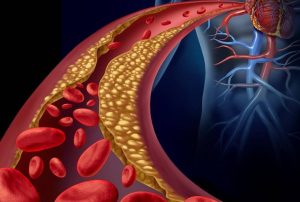
Elevated cholesterol levels can lead to health problems, especially heart problems. But it plays an important physiological role in maintaining the health of the body.
Cholesterol production is so important that the liver and intestines produce about 80 percent of the body’s cholesterol, and only about 20 percent of the cholesterol comes from the food you eat. If you consume only 200 to 300 mg of cholesterol per day (one egg yolk contains about 200 mg of cholesterol), your liver produces 800 mg of other nutrients such as fat, sugar, and protein.
All cells in the body need cholesterol, which helps to form layers in the cell membrane. These layers protect its contents by controlling what can enter and leave the cell. Cholesterol is made in the liver and is also used by the liver to produce bile, which helps digest food. Cholesterol is needed for the production of vitamin D in the skin. The liver produces enough cholesterol for the body to perform these important functions.
Cholesterol is also required to produce steroid hormones, especially sex hormones such as testosterone and progesterone. Cholesterol is also necessary for producing other hormones, which are mainly produced by the adrenal glands. Aldosterone (a hormone that helps the kidneys retain water) and cortisol (an important hormone in suppressing inflammation in the body) are two hormones. In addition, triglycerides (fatty acids in food) are an important source for the body, especially when glucose is low.
Because cholesterol is a type of fat, it cannot circulate in the bloodstream alone, in which case it eventually turns into useless pellets. The body binds cholesterol and other lipids in small particles coated with protein and easily mixed with blood to solve this problem. These tiny particles, called lipoproteins (lipids along with protein), carry cholesterol and other fats throughout the body (lipids are a large group of micronutrients that play an important role as structural molecules and energy sources. The main difference between lipids and fats is lipids (a large group of biological molecules, while fats are lipid).
Cholesterol and other lipids circulate in the bloodstream in different ways. Among them, low-density lipoprotein or LDL, known as bad cholesterol, is the most notable. But lipoproteins come in different shapes and sizes, and each has specific functions. They also have other conditions.
Types of cholesterol
Fats do not dissolve in water. Because water is a major component of the body, fats must be transported to proteins to be transported throughout the body, which, as mentioned, leads to the production of lipoproteins. Five different lipoproteins have been identified, each playing a specific role in transporting lipids in the body. Cholesterol is carried throughout the body by lipoproteins in the blood. These lipoproteins are:
- Kilomicrons
- Low-density lipoprotein (LDL) or bad cholesterol
- High-density lipoprotein (HDL) or good cholesterol
- Very low-density lipoprotein (VLDL)
- Medium Density Lipoprotein (IDL)
Kilomicrons
Chylomicron is responsible for packing and transporting fats in food. They are produced in the intestinal wall and, after formation, are absorbed by the intestinal lymphatic system. Chylomicrons are very large particles that carry most of the triglycerides (fatty acids in your food). They are made in the digestive tract and are therefore influenced by the food you eat.
Chylomicrons are carried by the lymphatic system and eventually enter the bloodstream. They are then transported to the liver, where the cholesterol is absorbed by the liver cells. Chylomicrons also enter the body where triglycerides are absorbed, where triglycerides are used as energy or stored in adipose tissue.
Very low-density lipoproteins
Very low-density lipoprotein (VLDL) is produced by the liver and carries triglycerides and cholesterol. These lipoproteins circulate in the bloodstream and mainly deliver triglycerides to the body’s cells to have the energy needed for specific cellular functions. When the body’s cells receive fatty acids from VLDL, these particles are converted to medium-density lipoproteins, which, if further extracted, eventually turn into LDL particles.
Medium-density lipoproteins
When VLDL release a significant portion of the triglycerides they carry, they are converted. But if they remove the remaining triglycerides, they eventually turn into low-density lipoproteins.
Low-density lipoproteins
Low-density lipoprotein (LDL) proteins are the same VLDLs that release most of the triglyceride loads they contain. Their main fat is now cholesterol. This changes the density of the lipoprotein. LDL becomes the main capsule of cholesterol transport produced by the liver. LDLs circulate in the bloodstream and deliver cholesterol to cells when needed. LDL particles are known as bad cholesterol because they carry cholesterol to the tissues and are strongly associated with the accumulation of vascular occlusion plaques.
High-density lipoproteins
High-density lipoprotein (HDL), called good cholesterol, plays a very different role than other types of lipoproteins. The liver produces HDL, and when it enters the bloodstream, it is essentially an empty vehicle. The role of HDL in the bloodstream is to collect excessive levels of cholesterol in peripheral tissues and transport them to the liver for recycling.
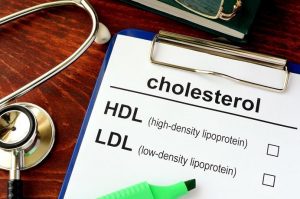
If cholesterol is needed, why worry about how much it is in your body?
Having enough cholesterol is important to meet the body’s needs. But having too much cholesterol can cause problems. If your cholesterol level is high, you are said to have high cholesterol. If your cholesterol level is low, you have hypocholesterolemia. Having very low cholesterol levels is not uncommon, but it can happen.
Why is low-density lipoprotein (LDL) bad?
When we always hear that our cholesterol should be low, it may seem strange that low-density lipoprotein is called bad cholesterol. However, low-density lipoprotein is detrimental to its function.
Low-density lipoproteins can accumulate in the walls of arteries and narrow them. These fatty deposits form plaques that cover the walls of the arteries and may block them. This accumulation is called atherosclerosis or atherosclerosis. Arteries are blood vessels that carry oxygen-rich blood from the heart to other parts of the body.
The fats associated with LDL cholesterol levels and the fats you should minimize in your diet are saturated and trans fats. Saturated fats are solid or waxy at room temperature. Saturated fats are mainly found in meat, milk, cheese, and butter obtained from animals. Trans fats are the result of a hydrogenation process in which liquid fats are converted to solid fats. Trans fats are found in fast foods and fried foods and increase the shelf life of processed products such as cookies and pastries.
Why is high-density lipoprotein (HDL) good?
High-density lipoprotein is called good cholesterol because it removes other cholesterol (including LDL) from the arteries. This type of cholesterol carries different types of cholesterol to the liver for excretion from the body. Higher HDL levels are believed to reduce the risk of heart disease.
Signs and symptoms of high cholesterol:
High cholesterol has no symptoms, and the only way is a blood test. This situation, in most cases, causes an emergency. For example, a heart attack or stroke can be caused by damage caused by high cholesterol.
What is a blood cholesterol test?
People over the age of 20 should have their cholesterol levels measured at least every five years. Your doctor will order a blood test that shows your blood cholesterol level. You may also have a blood lipid profile test or fat panel that gives you the following numbers:
- Total Cholesterol (Total Cholesterol)
- LDL level
- HDL level
- VLDL and triglyceride levels
- Non-HDL cholesterol
- The ratio of total cholesterol to HDL
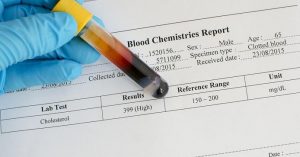
Advanced tests break down cholesterol levels into more components and determine the number of LDL particles, but these tests are not usually ordered. The creators of these tests say that more advanced tests better show who is at risk for heart disease, but most healthcare providers believe that routine tests are enough.
How is total cholesterol or blood cholesterol test done?
This type of blood test is a common test. The phlebotomist responsible for drawing blood usually collects some blood from the vein in your arm.
In most cases, you should fast for 9 to 12 hours before the test. In some cases, such as health screening tests, fasting cholesterol tests may be done for people under 20 or those unable to fast. Some medical societies believe that fasting is not necessary to get a true picture of blood lipid levels. In contrast, others believe that fasting gives people a better idea of the risk of heart disease.
How long does it take for a cholesterol test result to be ready?
Results are often produced within a day or two, and in some cases, earlier, usually in milligrams per deciliter (mg per deciliter).
Cholesterol Numbers: What Do They Mean?
Important numbers are total cholesterol, HDL or good cholesterol, LDL or bad cholesterol, and triglycerides.
How much is normal cholesterol?
Normal cholesterol levels vary depending on age and sex. High cholesterol levels vary with age and gender and may differ for people with heart disease. These guidelines show cholesterol levels for people who do not have heart disease.
LDL cholesterol levels
If you do not have cardiovascular disease and are not at risk for heart disease, your optimal LDL level is less than 100 mg / dL. If you have cardiovascular disease or risk factors, your doctor may want your LDL level to be less than 70 mg / dL. If you have diabetes, your optimal LDL level should be less than 100 mg / dL or even below 70 mg / dL.
triglyceride
Triglycerides are very important because most of your body fat is in the form of triglycerides. These levels are often higher in people with diabetes or obesity. Here’s what you need to know about triglycerides:
- Less than 150 is normal.
- Between 150 and 199, the border is open.
- Its height is between 200 and 499.
- Five hundred or more is too much.
HDL cholesterol levels
- The number you want most is HDL (remember, this is the good cholesterol).
- HDL is below 40 and is a risk factor for heart disease in both men and women.
- HDL has been a goal for 40 years and above, and it is good to achieve it.
- HDL is a goal for women 50 and older, and it is good to achieve it.
- HDL 60 or higher is a good level for protection against heart disease.
What is the good ratio of LDL to HDL?
In general, the higher the HDL and the lower the LDL, the better. Optimal cholesterol levels are determined by examining the ratio of HDL to total cholesterol. This ratio is calculated by dividing the amount of total cholesterol by the HDL result. For example, if your total cholesterol is 150 and your HDL is 50, your score will be 3 to 1. In general, the higher the number, the greater the risk of heart problems. Doctors want to see a ratio of less than 5 to 1, and a 3.5 to 1 balance is ideal. Lowering LDL lowers total cholesterol and improves this ratio.
Can bad cholesterol levels be too low? Can good cholesterol levels be too high?
Very low levels of bad cholesterol or very high levels of good cholesterol are not common. Studies show that high and very low cholesterol levels are not good for anyone. Although there is no definitive figure for low LDL levels, levels below 40 mg / dL may be associated with health problems such as depression, anxiety, and hemorrhagic stroke. However, data from clinical trials show that when a person is treated with a statin and the LDL level remains below 40 mg / dL, no harm is done.
In some cases, genetic diseases can cause very low cholesterol levels. In other cases, nutritional problems, cancers, hypothyroidism (hypothyroidism), and some infections can lower cholesterol levels. In each case, they have seized it, despite obstacles we can scarcely imagine. “
Scientists are also studying the effects of very high levels of HDL, which are good cholesterol and not definitive. But there are studies on the possible link between high HDL and cancer and an increased risk of a heart attack in people at risk.
Factors affecting blood cholesterol:
Several factors can affect your cholesterol levels, including:
Diet: Saturated fats, trans fats, and cholesterol in the food you eat increase cholesterol levels. Try to reduce the number of saturated fats, trans fats, and cholesterol in your diet. This helps lower your blood cholesterol levels. Saturated and trans fats have the greatest effect on blood cholesterol.
Overweight: Overweight, in addition to being a risk factor for heart disease, can increase triglycerides. Weight loss will be followed by fatigue and constant tiredness.
Exercise: Regular exercise can lower total cholesterol levels. The practice has the greatest effect on lowering triglycerides and increasing HDL. Try to do 30 minutes of physical activity most days of the week.
Age and sex: Cholesterol levels increase with age. Before menopause, women usually have lower total cholesterol than men in the younger age group. However, after menopause, women’s LDL levels increase generally, and HDL can decrease.
Inheritance: Your genes determine your body’s cholesterol levels. High blood cholesterol can be familial.
What do you need to know about cholesterol and heart disease?
Prevention and treatment of heart disease is the main reason for checking blood cholesterol levels. Heart disease is a general term that may be used to refer to a variety of diseases.
Treatment of high cholesterol
There are several ways to lower blood cholesterol (total cholesterol), including lifestyle changes, medications, or both.
Lifestyle modifications: Doctors usually start with non-invasive treatments such as lifestyle changes. Recommended for:
Avoid smoking: If you smoke, quit because it is harmful to you in many ways, and one of the consequences of smoking is lowering good cholesterol levels.
Change your diet: Limit your intake of trans and saturated fats. Eat heart-healthy foods such as fruits, vegetables, poultry, fish, and whole grains. Limit red meat, sugar, and dairy products made with whole milk.
Exercise: Try to exercise for 150 minutes every week or about 30 minutes on most days of the week.
Maintaining a healthy weight: If you need to lose weight, talk to a specialist about safe ways. You will see weight loss results even before you reach your ideal weight. Losing even 10% of your body weight can change your cholesterol levels.
Reducing the Impact of Negative Emotions: Learn healthy ways to deal with anger, stress, or other negative emotions.
Blood sugar and blood pressure control: Try to keep your blood sugar and blood pressure within a healthy range as recommended by your doctor.
Blood Cholesterol-Lowering Drugs:
Several drugs are designed to treat high cholesterol.
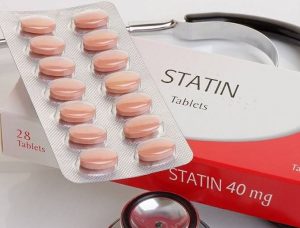
Statins: Statins are one of the most well-known groups of cholesterol drugs. The mechanism of action of statins is to reduce the amount of cholesterol produced by the liver. Statins lower blood cholesterol and may help reduce the risk of heart attack and stroke, which is one of the most commonly prescribed reasons. Some common statins include atorvastatin, fluvastatin, lovastatin, pravastatin, rosvastatin, simvastatin, and pitavastatin. Statins are not recommended for everyone with high cholesterol, especially those with liver problems. Although side effects of statins are less common, they can include muscle pain, high blood sugar, and memory problems.
Bile acid-binding drugs: Another group of medications prescribed to treat high cholesterol. These drugs, also called resins, bind to bile acids. Therefore, bile acids cannot be used for digestion. In response, the liver uses more cholesterol to produce bile. These medications include cholestyramine, colestipol, and collar. Resins are not suitable for everyone and also have side effects such as constipation and stomach pain.
Fibers: They are also called fabric acid derivatives. These drugs are more effective than lowering LDL cholesterol in reducing triglyceride levels. They may also help raise HDL cholesterol levels. Fenofibrate and gemfibrozil belong to this group of drugs.
Other medications your doctor may prescribe to lower LDL cholesterol levels include:
- PCSK9 inhibitors include alirocumab and olucamb
- Selective cholesterol absorption inhibitors such as axitinib
- Citrate lyase triphosphate (ACL) inhibitors such as bumped acid
- Omega 3 fatty acids and esters of fatty acids
- Nicotinic acid (niacin)
If you have taken statins and this medicine has not been able to bring your LDL to the desired level, you may be prescribed these medicines.
For people who are not helped by lifestyle changes and medications (often those with a genetic problem), a process called lipoprotein prediction is used. This includes using equipment to remove lipoproteins from the blood and plasma and then returning the blood and plasma to the body. This process may be combined with new drugs.
What are the side effects of not treating high cholesterol?
The main cause of high cholesterol treatment is coronary heart disease (CHD), also called coronary artery disease. Coronary heart disease occurs when the heart cannot receive enough oxygen-rich blood for normal function and is the leading cause of death. Coronary heart disease usually refers to large arteries, but coronary artery disease also affects and damages small blood vessels.
Can you prevent the formation of cholesterol deposits?
Researchers are trying to find ways to remove plaque (cholesterol deposits) from the coronary arteries. One suggested method is to use a combination of drugs (statins and PCSK9 inhibitors) in healthy people aged 25 to 55 years. It is said that if the level of cholesterol in the arteries is greatly reduced, it helps to clear and heal them.
Some researchers believe that a plant-based diet is a key to preventing heart disease. Some studies have shown that restricting nutrition to plant-based foods lowers cholesterol and, in some cases, platelet aggregation.
How can you prevent high cholesterol and coronary heart disease?
Prevention methods are similar to treatment methods. Quit smoking and quit smoking. Find ways to add physical activity to your daily routine. Try to keep your weight in a healthy range.
How much cholesterol should you consume per day?
Previously, doctors advised you not to consume more than 300 mg of cholesterol according to dietary guidelines (200 mg in case of risk of heart disease) per day. But in 2015, those recommendations changed. This change in policies is due to research showing that dietary cholesterol is not harmful and has no role in raising blood cholesterol levels.
Currently, there are no specific restrictions on the amount of cholesterol in food. But it is still important to pay attention to the food you eat to keep cholesterol levels within a healthy range. Doctors now recommend limiting saturated fats, trans fats, and extra sugars in your diet. Of course, you should also be careful about your cholesterol intake because foods high in cholesterol usually also have high saturated fats.
Cholesterol is a natural substance produced in your body and is also found in foods of animal origin. Your body needs cholesterol to help build cells and produce certain hormones, and it has the cholesterol it needs by using fats, sugars, and proteins in the liver and intestines. But this problem occurs when you consume a lot of saturated and trans fats. These types of fats cause your liver to produce a lot of bad cholesterol, which is in the form of deposits that clog arteries. For this reason, experts recommend that you avoid trans fats altogether and reduce your intake of saturated fats to ten percent or less of your total calories.
According to the above recommendation, a person who consumes 2000 calories per day should provide 200 calories (22 grams) or less through saturated fats. Of course, the American Heart Association’s latest recommendation is to limit your intake of saturated fats to 5 to 6 percent of your total daily calories. So for a 2000 calorie diet, it could be about 100 to 120 calories or about 11 to 13 grams.
Studies have also shown a negative effect of increasing sugars on cholesterol and increasing the risk of cardiovascular disease. The American Heart Association recommends that women consume no more than six teaspoons (100 calories) and men no more than nine teaspoons (150 calories) of extra sugar per day.
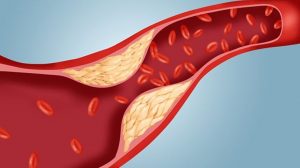
The importance of consuming soluble fiber in lowering cholesterol:
Dietary fiber is found in fruits, vegetables, beans, lentils, and whole grains. These nutrient-rich foods contain two types of fiber, one soluble and one insoluble, important for good health. Getting enough fiber from a variety of foods is important for everyone.
Research has shown that soluble fiber, especially from fruits, vegetables, beans, lentils, and whole grains, may help lower cholesterol. The dissolved thread in the stomach is a thick, jelly-like substance that binds to food cholesterol. So, eat lots of vegetables and fruits: Choose fruits with soluble fiber—for example, figs, Brussels sprouts, peaches, carrots, apricots, mangoes, and oranges.
Increase your vegetarian diet to more vegetarian by consuming legumes, lentils, and soy foods. Focus on the complete form of the product, which includes fresh, frozen, canned, or dried. Look for canned fruits that are packaged in plain water or your water. Choose canned vegetables that are low in salt or have no extra salt.
Whole grains are also a good way to get dietary fiber. Make sure your bread label is 100% whole grains, or one of the whole grains is one of the first ingredients. Limit refined carbohydrates, especially products containing added sugar, such as sweets and sugary drinks.
Cholesterol is found only in foods of animal origin, such as:
- Meat
- dairy products
- Seafood
- Butter
- Shrimp are high in cholesterol but very low in saturated fat and can be eaten as part of a heart-healthy diet.
- Cholesterol-free foods
Cholesterol is not found in the following foods:
- Fruits
- the vegetables
- Cereals
- Plant kernels
- They are also part of a healthy balanced diet.
- Foods that contain fat
Foods that are high in saturated fat and should be limited include:
- Red Meat
- Products such as cakes and cookies
- Cheese
- Pizza
- Ice cream
- Processed meats such as sausages
- Fried foods
Foods that contain unhealthy saturated fats should be avoided:
- Fried foods
- Packaged foods that use hydrogenated oils
- Sweets
- Margarine
- Popcorn is prepared in the microwave
- Steps of preparing cakes and sweets
Foods that contain healthy unsaturated fats that you should eat include:
- Sunflower oil, olive, peanut, canola, safflower
- Avocado
- Most plant kernels, especially walnuts
- Most seeds, including sunflower seeds, chia, and hemp
Conclusion: High cholesterol is a predisposing factor for cardiovascular disease that usually has no symptoms and can only be detected by blood tests. Lifestyle changes and medications help lower cholesterol and prevent disease.


